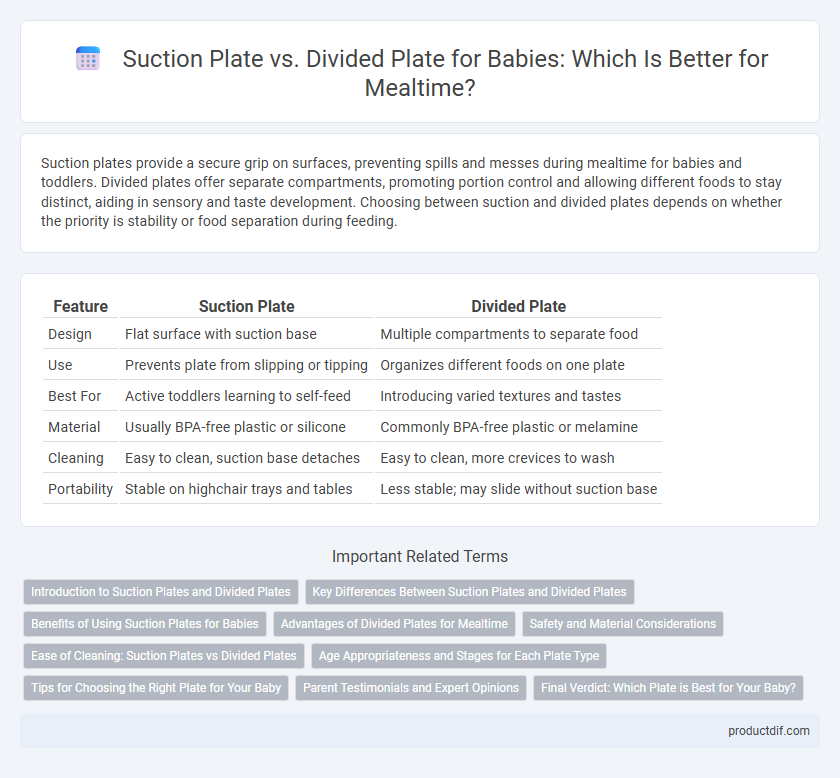Suction plates provide a secure grip on surfaces, preventing spills and messes during mealtime for babies and toddlers. Divided plates offer separate compartments, promoting portion control and allowing different foods to stay distinct, aiding in sensory and taste development. Choosing between suction and divided plates depends on whether the priority is stability or food separation during feeding.
Table of Comparison
| Feature | Suction Plate | Divided Plate |
|---|---|---|
| Design | Flat surface with suction base | Multiple compartments to separate food |
| Use | Prevents plate from slipping or tipping | Organizes different foods on one plate |
| Best For | Active toddlers learning to self-feed | Introducing varied textures and tastes |
| Material | Usually BPA-free plastic or silicone | Commonly BPA-free plastic or melamine |
| Cleaning | Easy to clean, suction base detaches | Easy to clean, more crevices to wash |
| Portability | Stable on highchair trays and tables | Less stable; may slide without suction base |
Introduction to Suction Plates and Divided Plates
Suction plates feature a strong silicone base that securely adheres to highchair trays or tables, preventing spills and messes during mealtime. Divided plates are designed with separate compartments to keep different foods apart, making them ideal for picky eaters and balanced portion control. Both products enhance mealtime efficiency and cleanliness, offering practical solutions tailored to infants' and toddlers' eating habits.
Key Differences Between Suction Plates and Divided Plates
Suction plates feature a strong adhesive base that securely attaches to highchair trays or tables, preventing spills and encouraging independent eating, while divided plates separate food into distinct compartments, promoting portion control and keeping flavors from mixing. Suction plates are ideal for young toddlers who are prone to knocking over their dishes, whereas divided plates are better suited for older babies transitioning to self-feeding and exploring different tastes. Both types support developmental milestones but address different challenges in mealtime management and child safety.
Benefits of Using Suction Plates for Babies
Suction plates provide a secure grip on highchair trays, reducing the risk of spills and messes during mealtime, which helps babies develop self-feeding skills with less frustration. These plates promote independence by staying firmly in place, allowing infants to explore different textures and flavors without the constant need for parental intervention. The non-slip feature of suction plates enhances safety and cleanliness, making them an essential tool in fostering positive eating habits in young children.
Advantages of Divided Plates for Mealtime
Divided plates offer distinct advantages for baby mealtime by keeping different foods separated, which helps prevent mixing of flavors and textures that can be overwhelming for picky eaters. These plates also promote portion control and balanced nutrition by clearly delimiting servings of fruits, vegetables, and proteins. Easy to use and often made with non-slip materials, divided plates enhance mealtime efficiency and encourage independent feeding skills in babies.
Safety and Material Considerations
Suction plates are designed with non-toxic, BPA-free silicone bases that securely adhere to surfaces, reducing the risk of spills and choking hazards during mealtime. Divided plates, often made from food-grade polypropylene or melamine, provide separate compartments to prevent food mixing but require careful material selection to avoid harmful chemicals like BPA or phthalates. Prioritizing plates with certifications such as FDA approval or LFGB compliance ensures enhanced safety and durability for baby use.
Ease of Cleaning: Suction Plates vs Divided Plates
Suction plates feature a smooth, single surface that simplifies cleaning by reducing crevices where food can get trapped, making them more hygienic and quicker to wash compared to divided plates. Divided plates often have multiple compartments that can accumulate food residues, requiring more detailed scrubbing to ensure thorough cleanliness. Parents seeking hassle-free maintenance often prefer suction plates for their ease of cleaning and reduced risk of bacterial buildup.
Age Appropriateness and Stages for Each Plate Type
Suction plates are ideal for babies aged 6 months and up during the early self-feeding stage, providing stability and reducing spills as they develop motor skills. Divided plates suit toddlers aged 12 months and older who begin to self-feed more independently, promoting portion control and varied food exposure. Choosing the right plate supports developmental milestones and encourages healthy eating habits in each growth phase.
Tips for Choosing the Right Plate for Your Baby
When choosing the right plate for your baby, prioritize safety features such as BPA-free materials and non-slip bottoms found in suction plates to prevent spills and make mealtime less stressful. Divided plates are advantageous for introducing various foods simultaneously while helping toddlers develop portion control and sensory exploration. Consider your baby's age, eating habits, and developmental stage to select a plate that supports their independence and prevents messes effectively.
Parent Testimonials and Expert Opinions
Parents highlight suction plates for their strong grip on surfaces, preventing spills and making mealtime less messy, while divided plates are praised for encouraging portion control and introducing variety in meals. Experts recommend suction plates for younger babies who are learning motor skills, noting the stability helps reduce frustration during self-feeding. Divided plates receive expert endorsement for toddlers transitioning to solid foods, as the compartments promote balanced nutrition and make it easier to offer multiple food textures.
Final Verdict: Which Plate is Best for Your Baby?
Suction plates provide stability and prevent spills, making them ideal for active toddlers learning to self-feed, while divided plates help separate different foods, encouraging picky eaters to explore varied tastes and textures. Choose a suction plate if your baby tends to knock dishes over or enjoys independence during mealtime; opt for a divided plate to promote balanced nutrition and portion control. Ultimately, the best plate combines non-toxic, BPA-free materials with features that suit your baby's developmental stage and eating habits.
Suction plate vs divided plate Infographic

 productdif.com
productdif.com